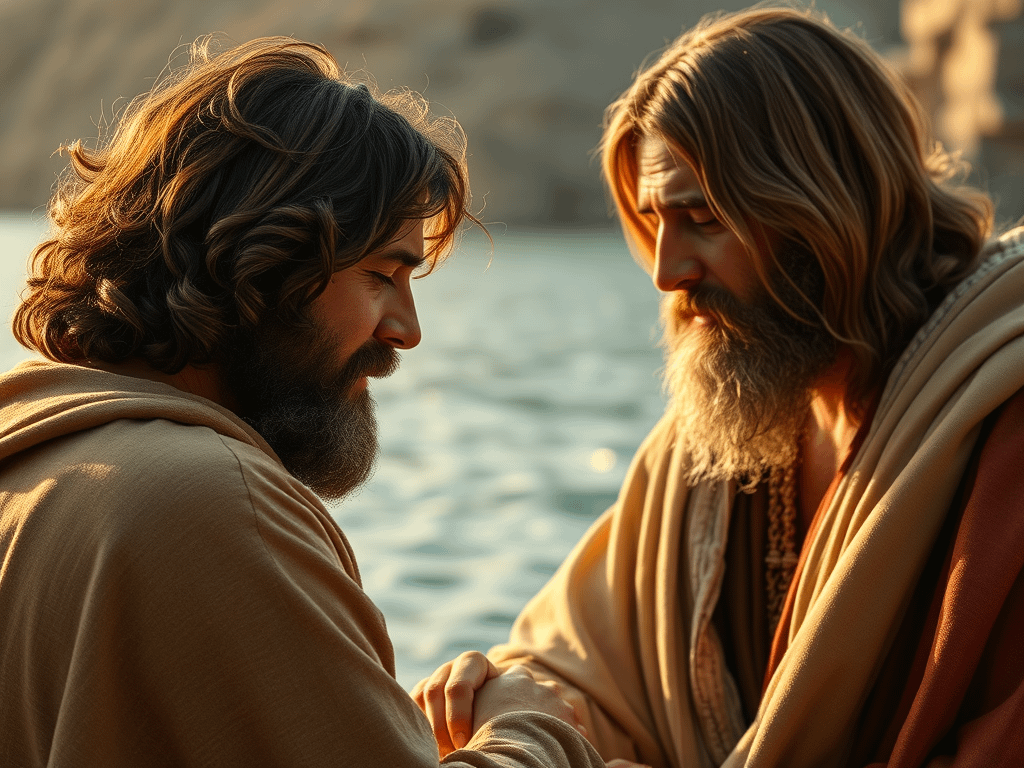Peter in the Bible – Who Was He and What Did He Do?
Peter in the Bible: Ever wondered about the man who walked on water (briefly!) and then denied knowing Jesus three times? Peter is arguably one of the most fascinating and complex figures in the New Testament. His story is one of extraordinary faith, glaring failure, and incredible redemption. But who exactly was Peter in the Bible, and what was his impact?
If you’ve heard his name but aren’t sure about his full story, you’re in the right place. This article dives deep into the life of the disciple Jesus called “the rock,” exploring his journey from a simple fisherman to a pillar of the early Christian church. Get ready to uncover the key moments and lasting legacy of this pivotal biblical character.
Who Was Simon Peter?
Before he was known as Peter, he was Simon, a fisherman from Bethsaida on the Sea of Galilee. He worked alongside his brother Andrew and partners James and John. His life was likely typical for the time and place – hard work, family, and the rhythms of the fishing trade.
His world changed forever when he met Jesus. John the Baptist’s disciple, Andrew, first brought Simon to Jesus, declaring, “We have found the Messiah!” (John 1:41). Jesus immediately looked at Simon and said, “You are Simon son of John. You will be called Cephas” (which, when translated, is Peter).
The Significance of the Name Change
Giving someone a new name in the Bible often signifies a new identity or purpose. Jesus calling Simon “Peter” (from the Greek word petra, meaning “rock”) was prophetic. It foreshadowed his crucial role in building the early church, as Jesus later stated, “And I tell you that you are Peter, and on this rock I will build my church, and the gates of Hades will not overcome it” (Matthew 16:18).
Peter’s Call and Early Ministry with Jesus
Jesus didn’t just meet Peter; He called him directly. The Gospels describe Jesus seeing Simon and Andrew casting nets and saying, “Come, follow me, and I will send you out to fish for people” (Matthew 4:19). They immediately dropped everything and followed Him.
Peter became one of Jesus’ closest disciples, part of the inner circle along with James and John. This gave him unique access to key moments, including:
- The raising of Jairus’s daughter (Mark 5:37)
- The Transfiguration (Matthew 17:1)
- The agony in the Garden of Gethsemane (Matthew 26:37)
Throughout Jesus’ ministry, Peter was often the spokesman for the disciples – bold, sometimes impulsive, but deeply devoted. He was quick to speak, quick to act, and sometimes quick to err.
Key Moments in Peter’s Relationship with Jesus
Peter’s journey with Jesus was filled with dramatic ups and downs that highlight his human nature and God’s grace.
Walking on Water
One of the most famous stories is Peter walking on water (Matthew 14:28-31). When the disciples saw Jesus walking on the sea, they were terrified. Peter, with his characteristic boldness, called out, “Lord, if it’s you, tell me to come to you on the water.”
Jesus said, “Come.” Peter stepped out of the boat and began walking towards Jesus. However, when he saw the wind, he became frightened and began to sink, crying out, “Lord, save me!” Jesus immediately reached out, caught him, and gently rebuked him, “You of little faith, why did you doubt?”
This moment perfectly captures Peter: great faith mixed with human fear and doubt, followed by Jesus’ immediate rescue and compassion.
The Confession of Christ
At a pivotal moment near Caesarea Philippi, Jesus asked his disciples, “Who do people say the Son of Man is?” After hearing various answers, He turned to them and asked, “But what about you? Who do you say I am?” Simon Peter answered, “You are the Messiah, the Son of the living God” (Matthew 16:13-16).
Jesus blessed Peter for this confession, stating that it was revealed not by human insight but by His Father in heaven. This is the moment Jesus declared Peter would be the “rock” upon which He would build His church, giving him “the keys of the kingdom of heaven” (Matthew 16:19).
The Denial and Restoration
Despite his strong confession and promises of loyalty, Peter famously denied Jesus three times on the night of Jesus’ arrest (Matthew 26:69-75). This was a devastating failure, fulfilling Jesus’ earlier prophecy. When the rooster crowed and Jesus looked at him, Peter went out and wept bitterly.
This wasn’t the end of Peter’s story, however. After His resurrection, Jesus specifically appeared to Peter (Luke 24:34, 1 Corinthians 15:5).
Later, by the Sea of Galilee, Jesus met Peter and the other disciples, asking Peter three times, “Simon son of John, do you love me?” (John 21:15-19). Each time Peter affirmed his love, Jesus instructed him, “Feed my lambs,” or “Take care of my sheep.” This conversation beautifully illustrates Jesus’ grace, restoring Peter to ministry despite his earlier failure.

Peter’s Role in the Early Church After Jesus’ Ascension
Following Jesus’ ascension, Peter emerged as a prominent leader among the apostles. His transformation from fearful denier to bold preacher is a testament to the power of the Holy Spirit.
Preaching at Pentecost
On the day of Pentecost, when the Holy Spirit descended, it was Peter who stood up and preached to the gathered crowds (Acts 2:14-41). His powerful sermon explained the events they were witnessing and declared Jesus as Lord and Messiah. The result was astounding: about 3,000 people were converted and baptized that day.
Healing and Miracles
Peter was instrumental in the early church’s ministry of healing and miracles. He, along with John, healed a lame beggar at the Beautiful Gate of the temple (Acts 3). His shadow passing over people was said to bring healing (Acts 5:15).
Leadership and Authority
Peter played a key role in several significant early church decisions:
- Selecting a replacement for Judas Iscariot (Acts 1:15-26)
- Addressing internal issues, such as the case of Ananias and Sapphira (Acts 5)
- Being the first to preach the Gospel to Gentiles, through the conversion of Cornelius and his household (Acts 10). This was a crucial turning point, confirming that salvation was for all people, not just Jews.
His leadership wasn’t without challenges, as seen in his interaction with Paul regarding the inclusion of Gentiles (Galatians 2:11-14), demonstrating that even pillars of the church were still growing in their understanding.
Peter’s Later Life and Legacy
According to church tradition, Peter ministered extensively, possibly traveling to various regions. The New Testament includes two letters attributed to him: 1 Peter and 2 Peter, which offer guidance, encouragement, and warnings to early Christians facing persecution and false teaching.
Tradition holds that Peter was martyred in Rome during the reign of Emperor Nero, likely around 64 AD. The story, first recorded by the church father Tertullian, says that Peter requested to be crucified upside down, feeling unworthy to die in the same manner as Jesus.
Peter’s legacy is profound. He is remembered as:
- The bold confessor of Christ.
- The repentant follower restored by grace.
- The powerful preacher at Pentecost.
- A foundational leader of the early church.
- An author of New Testament epistles.
His story is a powerful reminder that God uses imperfect people – people with doubts, fears, and failures – to accomplish His perfect will. Peter’s journey from impetuous fisherman to steadfast apostle continues to inspire believers today.
Discover more about the amazing people of the Bible!
Conclusion
Peter in the Bible was a complex, dynamic figure – a man of deep faith and equally deep flaws. He was called by Jesus, walked intimately with Him, stumbled greatly, and was lovingly restored. His life, ministry, and writings were absolutely essential to the formation and spread of the early Christian church.
From denying Christ to preaching boldly before thousands, Peter’s story is one of incredible transformation powered by grace and the Holy Spirit. He truly became the “rock” Jesus envisioned, demonstrating that devotion, repentance, and faith can overcome even the most significant failures.
Want to learn more biblical stories? Explore our Blog!
Frequently Asked Questions
Before meeting Jesus, Peter (originally named Simon) was a fisherman working on the Sea of Galilee, likely alongside his brother Andrew and partners James and John.
Jesus renamed Simon “Peter” (Cephas in Aramaic), which means “rock.” This name was prophetic, signifying his future role as a foundational leader (“rock”) upon whom Jesus would build His church.
Key events include being called as a disciple, walking on water, his confession of Jesus as the Messiah, his denial of Jesus, and his restoration after the resurrection.
After Jesus’ ascension and the coming of the Holy Spirit at Pentecost, Peter became a leading figure among the apostles. He was the primary preacher at Pentecost, performed miracles, and played a crucial role in spreading the Gospel, including to Gentiles.
According to strong early church tradition, Peter was martyred in Rome during Emperor Nero’s reign, likely crucified. Tradition states he requested to be crucified upside down.


